Brand Development, Web Design, and Google Analytics Specialists
Experienced in SEM, SEO, Social Media, and Traditional Media
What Is NAP? Name, Address and Phone for Local SEO

NAP stands for name, address and phone number. Basically, it’s the basic information your customers will need to know if they want to do business with you.
You’re probably thinking, “Great! I’ve got all that information on my website. Job done. I have reached enough potential customers!” Well, it’s not that easy.
Your website may be up to date and may think that digital marketing isn’t for you or your business. But what about local listings through search engine optimization (SEO)? Like with local directories, if you haven’t kept tabs on these areas on your website or on social media, you might find that someone entered your phone number with a 3 instead of an 8 or that your old address is still listed. This will dramatically affect your local search ranking.
We’ll go over what NAP is, why it’s important for your business, and how you can ensure your NAP is consistent across the web.
What is NAP SEO? Why is it important?
NAP goes by many names. If you’ve never heard of NAP before, you may have heard of NAPW (name, address, phone number, website), or NAPU (name, address, phone number, URL). Basically, whichever you prefer it’s your business’ contact information.
It’s important that this information is correct across the internet, primarily so your customers can actually find you through local SEO. However, it’s also important because Google and other search engines take NAP consistency into account when they calculate search rankings.
What is NAP consistency and why does it matter?
So, what is NAP consistency? Simply put, it’s a measure of how well your business’ NAP information is consistent across various listings. Suppose you’re an electrician and your business is listed like this on your website:
Dave’s Electrical Contractors, Inc.
1234 Main Street
Smallville, KS 12345
888-765-4321
https://www.daveselectrical.com
So far, so good. But let’s say you have a Facebook page and your listing looks like this:
Dave’s Electrical Contractors
1234 Main St.
Smallville, KS 12345
888-765-4321
https://www.daveselectrical.com
The information is still accurate, but it’s not exactly the same. This won’t kill your search ranking. It won’t help it, either. But now let’s say your business is listed on Google like this:
DEC
1234 Main St.
Smallville
888-765-4821
https://www.daveselectrical.com
Wow! The name isn’t even recognizable and the phone number is wrong. A listing like that can really hurt your business’ search ranking. This is because Google’s algorithms will recognize the inconsistency and consider your NAP information unreliable.
You may be a master electrician with 20 years of experience, but it won’t matter because no one will find you in the first place. That’s why it’s so important to ensure your business listings have NAP consistency.
What are citations and how do I find them?
A citation is anywhere that your business’ NAP information is listed online. There are two types of citations: formal and informal.
Formal citations are the most important ones to keep track of. These are the listings you see on Google, Facebook, Yelp, and other websites that have specific listings. A good way to make sure these are accurate is to claim your business on those websites.
Methods of claiming your business vary depending on the website, but most major listings like Google and Yelp provide links for business owners to click. When you click on a link to claim your business, you’ll then go through an identity verification process to make sure it’s actually your business.
This can be challenging, particularly if your business has been around a long time and is listed on many websites. Unfortunately, the alternative is to rely on members of the public to keep your NAP information accurate. Even if they do, they’re liable to make typos or use abbreviations that can hurt your search rankings.
The other type of citation, an informal citation, is one that’s not an official directory listing but appears somewhere on a website. For example, if your business was reviewed by a local newspaper, there’s a good chance your name and phone number are listed in the article.
These citations can be difficult to fix. In fact, the only thing you can do is make sure you’re providing the right information whenever you’re asked. Even if you do, informal citations won’t get updated when you change addresses or phone numbers. Fortunately, this kind of citation isn’t very important for search engine rankings.
What are aggregators? Why are they important?
There are many local business listings on the web. Search for any city’s business listings like “San Diego business directory” and you’ll find a site or three that specializes in listing local businesses.
The same is true for specific industries. For example, lawyers have their own nationwide directory. Since these are niche sites, they don’t have the resources to obtain NAP information on their own, nor do they get enough traffic to depend on the public to keep their information accurate.
These sites depend on larger sites to keep their records up to date. These larger sites are called aggregators and your search ranking will live or die based on whether their information is correct.
This might sound like bad news, but it really isn’t. Imagine the headache of having to search for every possible niche site that might list your business and asking them to change it. You can get the same result just by contacting a handful of aggregators.
Here are some of the biggest aggregators you’ll want to look at:
- Infogroup – They work with some major GPS manufacturers. You want to make sure they have your address right.
- InfoUSA – InfoUSA is one of the biggest aggregators out there. They specialize in B2B listings, but also provide information to many other sites.
- Factual – They provide business listings to over 6,000 companies.
- Thomson Local – This is a smaller aggregator, but they specialize in local businesses.
- Acxiom – Another second-tier aggregator, but they make it very easy to update your business’ NAP info.
- Neustar Localeze – This service is made specifically for small businesses. They automatically monitor your business’ other listings online and update your information when possible.
Are there any shortcuts?
If this sounds like too much work, or if you’re not comfortable doing it, why not hire a professional to manage your NAP information? At Above The Fold we have years of experience managing local SEO campaigns for clients throughout San Diego. Contact us today for a free consultation.
The Seven Best Resources for Local SEO

The Seven Best Resources for Local SEO
As of November 2018, 60% of Americans used their phones or computers when searching for a local business. As this number continues to rise, it’s more important than ever to make sure your business has a strong web presence through digital marketing. To make it in today’s business world, when any potential clients make a local search, it is imperative to be at the top of the local listings.
Advertisers call this process search engine optimization (SEO). You may think that SEO tools are a daunting process to incorporate all ranking factors—something that only techies can do with their computer wizardry.
What if we told you that anyone can do SEO optimization and incorporate all local search ranking factors? Yes, even local business owners who don’t have any expertise on the internet. We’re about to show you seven ways to improve your business’ search rating and bring more customers through your doors.
Local SEO is more than Google
Google is the undisputed king of the internet and is involved in all ranking factors. In fact, 88% of Americans use Google for their internet searches, especially for a local search. That’s a huge number and it’s why nobody ever says “let me Yahoo that.”
For this reason, a lot of the advice we’re giving is centered around improving your Google rankings, which can be achieved with a local SEO strategy. That said, most of these guidelines apply to other search engines as well.
The best thing to do is to optimize your business listings for Google, then follow up with other search engines like Bing and Yahoo. By optimizing for 88% of searches, you’ll be setting yourself up to reach the highest number of customers.
Claim your business
The most important thing you can do to improve your local search ranking on the internet and on social media is to claim your business on search engines. This kind of marketing takes just a few minutes and will put you ahead of 56% of local businesses that haven’t even claimed their Google My Business (GMB) page.
What does this mean?
When you Google a business like “Electricians in San Diego,” you’ll notice that most of the businesses have their address, phone number and website listed. If you click on multiple results, you’ll notice that some of them have links that say “Suggest an Edit” and “Own this Business?”
If you click the link that says “Own this Business,” Google will need to verify your identity. Exactly how they do this has changed over the years, but it currently involves sending a postcard to your business’ physical address. The postcard contains a code, which you’ll have to enter into Google to complete the process.
Not claiming your business, will cause it to appear lower in search rankings, and will force you to rely on members of the public to keep your information up to date. Claiming your business allows you to keep your phone number, address and website up to date, as well a list your hours.
Do your keyword research
In SEO speak, keywords are the words that people use to look for a particular service. For example, if I’m an electrician in San Diego, how might people search for me? It’s not rocket science, just simple marketing.
They’d probably use terms like “electricians in San Diego,” “San Diego electrician” or “electrical work in San Diego.” So, how do you find out what keywords are popular for local businesses like yours?
Services like Moz and Ahrefs cost just a few dollars a month and will show you exactly what keywords people are using to find businesses that are similar to yours. By using these words in your site, you’ll increase the likelihood that these users will actually find you.
Provide useful information
Another way to improve your search ranking is to get people to stay on your site once they get there. In the early days of the internet, people would SEO optimize their websites by including blocks of text that are full of keywords. You’ve probably seen some of these sites. They look something like this:
Electricians San Diego, San Diego Electricians, Electrical workers San Diego, San Diego emergency Electrical repair, Electrical installers in San Diego, and so on for hundreds of similar keywords.
Needless to say, there’s nothing useful about this kind of keyword cramming. Since a search engine’s entire purpose is to provide useful information, they’ve started keeping track of how long people stay on a site once they’ve clicked on it. The theory is that people will stay longer if they actually find something of value.
For this reason, it’s a good idea to put a blog on your website or at least a few articles that are relevant to your business. Use relevant keywords in these articles, but make sure they sound natural. The overall goal here is to keep people from hitting their browser’s back button for as long as possible.
Make sure your mobile site works
With more and more people using their smartphones for internet searches, it’s no surprise that people appreciate a good mobile site. In fact, 61% of people who use their phones for searches won’t visit a business that doesn’t have a working mobile site.
Is this fair? No, it’s not. Unless you’re a web designer, building a mobile site probably isn’t part of your expertise. It certainly has nothing to do with how good your business.
But life isn’t fair, and we live in the age of the internet where people’s attention spans are shorter than ever. If you want to drive users to your business, you have to make it easy for them to learn about you. A good mobile site is essential for this.
Multiple landing pages for multiple locations
If your business has several locations throughout a region, creating multiple landing pages can help improve your local SEO ratings for each location. For example, if you own an electrical business with locations throughout the San Diego area, you might have several landing pages that look like this:
- Bestelectrician.com/San Diego
- Bestelectrician.com/La_Jolla
- Bestelectrician.com/La_Mesa
You can optimize each of these pages with keywords for those local areas, which will boost your search rankings.
Hire a professional
If all of this sounds too daunting, there are businesses that specialize in Local SEO optimization like our agency Above The Fold. If you’re interested in what our team has to offer, contact us today to receive a free consultation.
10 Common SEO Questions Asked By Small Business Owners

Are you a business owner in San Diego who is confused by SEO? Look no further as we answer 10 of the most common questions.
1. What does SEO stand for?
SEO is short for Search Engine Optimization. By engaging in SEO – that is, using keywords and phrases on your website, in your content and so on – you are attempting to push your website higher up the rankings. The ultimate goal is to usually get your website ranking on page 1 because most users rarely navigate beyond this page. This is known as SERPs or Search Engine Results Pages.
This is the organic way of growing your pages and website. In other words, you don’t pay for SEO itself – apart from the costs of creating content, employees, etc. Paying for adverts is not organic.
2. Does SEO stay the same?
SEO is always changing. The way people search, what they search for and how they search has changed over the last few years and will continue to do so.
For example, many people are now using their smartphones as their main device for accessing the internet so it means your website has to be mobile-friendly. It also means that Local SEO needs to be a big part of your marketing strategy to reach customers within a close proximity to your business.
Predictions are that more of us will be making voice searches in the future – in fact, by 2020 it is predicted half of us will be searching by voice – and that may mean a few changes to how your content needs to be formatted.
3. How are keywords and SEO related?
Keywords are intrinsically linked. Keywords are the words and phrases your customers use to find products, services or brands they want.
For example, they may search for “seo company in San Diego” or “fair trade coffee shops San Diego”. If you have these search terms and words in your content, it increases the likelihood of your website ranking higher in search engine results.
4. How do I know which keywords work for my business?
Good question! You need to do something called keyword research. There are various ways you can do this – an agency specializing in SEO, social media and websites etc. can help you – or you can conduct keyword research yourself by using a keyword tool you find online.
Many of these tools are free to use. You will need to search based on the products you sell, what kind of business you are and so on. From these broad parent topics, you will narrow your search.
Some keywords are commonly used by customers looking for a business or products like yours so to rank higher with these, you may find that success is much more difficult.
5. Where do I put SEO keywords?
There is a phrase ‘keyword stuffing’ and it implies that the frequency of keywords in ALL content is over the top, something that search engines algorithms no longer like.
Keywords and phrases need to be used naturally. They can be used across all your content, including web pages, meta titles, and meta descriptions just to name a few.
In terms of blog posts, whichever SEO term you have decided to optimize for, you would use it in the title of the post, in at least one H2 header (a sub-heading) and usually in the form of a question and in the first introductory paragraph.
6. How many times should I use the keywords?
Using keywords and phrases should be ‘organic’, in other words, not shoe-horned onto the end of every sentence! There is no set formula, regardless of what some people say because big search engines like Google never reveal all the details behind their algorithms.
Keywords that naturally occur three to four times in an average length blog post – between 500 and 750 words – is usually ‘about right’.
7. So I need to blog to improve SEO?
Blogging is a means of ranking higher in SERPs for certain keywords but again, this isn’t about loading a batch of blogs and hoping they work.
SEO is slightly more refined than this so any blogs need to be;
- Well-written
- Informative
- High-quality
- Consistently posted
- Shared via social media and other distribution channels
We recommend blog posts being around 1,000 words as a best practice.
8. How does SEO connect with backlinks?
The internet is a complex web of content linking to other pieces of content. This linking between websites help spread information and connect search engine spiders to the most relevant content. In general, the more links a piece of content has pointing to it from external sources, the more value the search engine algorithm will give it.
And that means the website and the content will be pushed higher up the rankings. Backlinks are a vote of confidence that other users see your content and website as trustworthy.
9. How do I build links?
At one time, companies would buy backlinks, something that is now a definite no-no! What you need to do is have a backlinking strategy to build links naturally and in a way that complies with Google best practices. In other words, who would want to share your content and connect with it?
The better quality these websites are and the higher their Domain Authority, the more value these backlinks have to your overall SEO strategy.
10. Is SEO complicated?
SEO isn’t extremely complicated, but to push the authority of your domain up and improve your rankings, you need to have a multi-faced SEO strategy. In other words, strong and relevant keywords, plenty of high-quality content and a growing number of genuine backlinks to your website.
Keeping up with the changes can be difficult, especially when you have so many daily business tasks to complete. By outsourcing SEO, you could get much more.
Speak With Our Team Today
If you have questions about SEO for your small business, speak with our team of experts today. We’d love to learn more about your business and offer a free consultation. Click here to get started today!
The Top 11 Benefits of Guest Blogging

* Original article *
Guest blogging is one of the best online marketing strategies you can invest in.
If you want to spread your brand’s message and win the trust of your target audience, start contributing content to other blogs related to your market or niche.
Not convinced you should work hard writing content for someone else’s site?
You should know that guest blogging offers many major benefits – both for your company and you, personally.
Here are the top 11 benefits of guest blogging.
1. Instant Exposure to Targeted Traffic
Regardless if you whether you get a link to your site, contributing to other blogs should pique your audience’s interest. If you manage to write a top-quality post, expect traffic to start flowing to your site once it goes live.
Traffic is the lifeblood of any online business or blog. Something as simple as a guest post can potentially translate into sales if you do it the right way.
Optimize your website’s landing pages, CTAs, and other elements to boost your chances at conversion.
2. Expand Your Personal Network
There was a time when connecting with influencers was extremely difficult. But with guest blogging, the process is now simple.
For example, some websites that accept guest posts foster a community of contributors engaged in related niches. In some cases, you’ll get the chance to take part in an email thread where contributors brainstorm potential topics. You can also collaborate with others for co-authored posts.
Regardless of what the community’s structure in a particular site is, you can always leverage your authorship. Seek partnership opportunities with influencers – from content cross-promotion to expert interviews.
All you need to do is be active in the community. Leave comments, share other posts, or cold-email your prospects. If possible, you can even invite influencers as contributors to your own blog.
3. Stimulate Social Media Shares
Generating social media shares is one way to exponentially extend your online reach. The more shares your branded content gets, the more shareworthy it’ll be in the eyes of your audience.
If you’re submitting a guest post to a blog with plenty of social media activity, then shares should come naturally once your content gets published.
To get the ball rolling faster, consider embedding highly shareable content in your guest post. Infographics, for example, can help you get 3x more engagement in social media than any other type of content.
4. Grow Your Social Media Following
Guest blogging not only increases the amount of social media shares to your content, it can also boost your follower count and accelerate your lead generation efforts.
By contributing to an authoritative blog, you are essentially getting them to vouch for your brand. This makes you look good in the eyes of their followers.
In most guest blogging arrangements, you also get to customize your contributor profile. Here you can include links to your social media accounts.
All these benefits will make it easier to win your target audience’s trust and turn them into active social media followers. Remember to reward them by posting regular updates and sharing useful information that aligns with their interests.
5. Improve Your Online Authority
Modern online marketing is all about authority. Even with the best content in the world, it’ll be difficult to convert your audience into loyal subscribers or paying customers if they don’t trust your brand.
By contributing to other authoritative blogs, you get the chance to prove your credibility as an information source. It will make your target audience realize that you’re someone who’s recognized by trustworthy brands. And as a result, they’ll be more receptive to any value proposition you may present in your own site.
6. Fortify Your Backlink Profile
Most blogs that accept guest posts allow their contributors to leave at least one link to their own site. After all, most of them don’t offer any monetary compensation for your hard work. A brief brand mention or keyword-optimized link is the least they could do to reward your efforts.
Still, even a single backlink from an authoritative blog will greatly benefit your SEO. They make your content more discoverable and indexable to search engines like Google. As much as possible, try to target websites in your own niche to build relevancy.
7. Grow Brand Awareness
Guest blogging is a great way to establish your authority in your niche.
As much as possible, try to share practical tips that aren’t already found elsewhere.
Leverage the opportunity to let them know what your company does and how it would solve problems.
Also, be sure to instill your brand’s voice into every single post you submit. This will make your personal brand more recognizable regardless of where you submit guest posts.
Some popular bloggers, such as Larry Kim, use a conversational and humorous approach to engage readers. They also avoid writing fluff while keeping sentences short and easy to read.
8. Generate Qualified Leads
One of the fundamental steps to a successful guest blogging strategy is picking the right websites.
In addition to niche relevancy, you also need to look for sites that already have a steady stream of traffic. This will help you connect with people who are already interested in what you offer as a business.
Always emphasize an actionable step when developing the page that you’re bringing traffic to. It should be related to the guest post you’ve submitted to the other blog. Otherwise, your link is nothing more than a disruption in your audience’s journey — a waste of time for them and a lost lead for you.
9. Shorten the Sales Cycle
The sales funnel has always been a challenge for content marketers. By distributing content through popular blogs, you are immediately building your target audience’s familiarity with your brand. Thus, you are shortening the sales cycle for your products and services.
Think of it this way: rather than waiting for potential leads to come to your site, you can introduce your brand’s value propositions in your guest posts.
You just need to be smart when picking or pitching topic ideas for your guest posts.
10. Get Useful Feedback from the Community
As a guest blogger, another advantage of being active in the community is that you get to receive insightful feedback from other contributors.
When you talk about strategies, for example, other experts may tune in to share their own ideas through the comments section. As a result, you can further develop or refine your strategy with their suggestions in mind.
To invite contributors to comment, try adding a call-to-action in the conclusion paragraph. You can refer to the end of this post to see how it works.
11. Sharpen Your Content Marketing Skills
Guest blogging requires every area of content marketing to be successful. It requires you to do content research, adopt the right writing voice for a particular audience, perform influencer outreach, and so on.
Remember, the best way to learn content marketing tactics is to deploy them yourself. You can’t just read about them, follow everything to the letter, and hope for the best.
By launching your own guest blogging campaign, you’re positioning yourself for growth in every facet of content marketing.
Conclusion
Guest blogging is, without a doubt, a crucial step for online marketing success. Once you grasp its benefits, give it a shot and see if you can make it work for your brand.
8 Can’t-Miss Off-Page SEO Strategies to Build Your Online Reputation

What is off-page SEO?
Off-page SEO is the act of optimizing your brand’s online and offline footprint through the use of content, relationships, and links to create an optimal experience for prospects and search engine crawl bots. It typically leads to gradual increases in positive brand mentions, search rankings, traffic to your site, and conversions.
Sounds fairly straightforward, right?
Well, for the attorney seated in front of me in my kid’s elementary school lunchroom, I might as well have just told him the earth is flat.
“That makes no sense to me,” he said, pushing his chin forward and tilting his head, as if waiting for me to admit that I was pulling his leg. “You mean, there’s all this stuff [an SEO] does on my site? And there is stuff that we — me, my team and [the SEO] — should be doing off our site as well? That’s like telling me, ‘It’s not enough that you live and pay for a nice house in a gated community. You also need to guard the gate to the community and pick up trash along the road leading up to your driveway.'”
His example could not have been more apt.
“Not caring about off-site SEO is like having that great house in the gated community, but none of your friends want to visit because they’ve heard from others that it smells like vomit on the inside, and no one they talk to can either confirm or deny it.”

By imagining your website as a home you’d like people to visit, it’s easier to see the value of off-site SEO.
I continued: “It’s not enough to only care about your website/brand or your house/neighborhood; you must always be working to enhance its reputation to ensure others will desire to visit/learn more about it.”
He saw the light.
“So basically we do off-site SEO to ensure the work we do onsite and as a brand are most effective?” he asked.
Exactly!
Why your brand cannot afford to ignore off-site SEO
In the SEO world, we don’t need to be convinced of the value of off-page SEO.
We know that well before people seek our brands out, they have formed an opinion of it based on reviews, comments from friends, family members, or online acquaintances, and whatever information we can glean online or offline (apart from your website).
Therefore, we’d be fools to disavow making off-page SEO a priority, given how important it is.
However, the more common mistake — among SEOs at least — is to see off-page SEO through only the prism of link building, which, while important, is not the be-all and end-all of off-page SEO.
That is, in working to build your brand’s off-page SEO prowess, links are certainly a benefit, not the goal.
Think of it this way:
- Goal of off-page SEO: To accumulate positive signals and interactions for your brand, with the hope of those factors being a net positive.
- Benefit(s) of off-page SEO: Brand mentions, positive reviews, links, etc.
So while it’s important to think of links when making off-page SEO a priority, it’s also vital that you (a) view them in context (important but not singularly so) and (b) give priority to the host of factors that lead to off-page SEO providing a boost for your brand.
Those factors include, but are not limited to, creating an excellent, worthwhile product or service; guest posting on popular, relevant blogs; building relationships with influencers; earning positive press; capturing positive reviews and responding to negative reviews; and monitoring mentions of your brand, to name a few.
Because our goal is to create a post that’s accessible, interesting and immediately useful, we’ll break down what we think are 8 key areas worth focusing on for off-page SEO under three umbrellas:
- Brand
- Audience
- Content
The intention is to provide a prism through which you can more easily categorize your efforts and a framework by which you can make those efforts a reality.
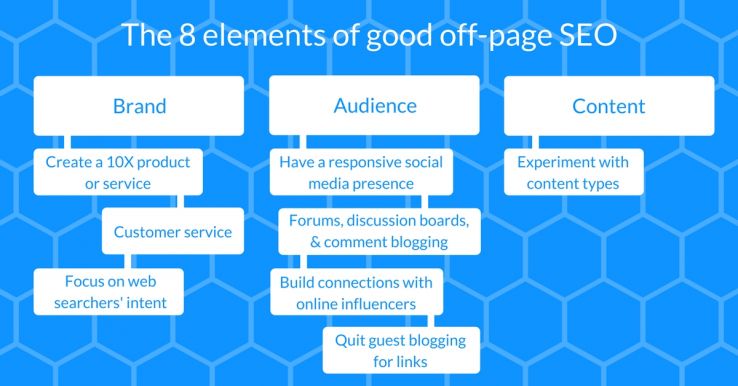
Brand
“No amount of SEO in the world can help a crappy product or service (at least not for long).” This is a sentence I frequently utter to folks who refuse to prioritize what they offer in favor of trying to put lipstick on a pig.
#1: Create a 10X product or service
When your product or service is recognized as the best in its class, your job as SEO becomes much, much easier.
That’s because both online and offline, people are likely saying great things about the product and brand, which leads to visits to your website, positive reviews on third-party sites, and increased sales of the product.
This only occurs, however, if you focus first and foremost on creating the best product you can.
Easier said than done, I know.
Here’s a great place to start, depending upon where your product/service is in the evolution cycle:
- Existing product: Deliver the goods on features customers would most benefit from based on requests and complaints online regarding competing products.
- New product: Focus on the most essential benefits your new product can provide to the prospective audience. When you do this, you remove objections and features present themselves.
#2: Customer service
No one who’s watched the United Airlines meltdown needs to be sold on the value of customer service as an effective asset for off-site SEO. The brand will be paying for that epic disaster for years as millions of folks continue to share the video and images of the event.
It’s not hard to imagine how poor customer service has made the brand’s SEO and PR teams’ reputation management efforts a nightmare.
For your brand, focus on a singular goal: Leaving everyone your brand/brand spokespeople comes into contact with — online or offline — feeling as though the interaction could not have been more positive.
For example, at in-person events, make sure staffers wear a smile, empathetically interact with everyone they meet, and go out of their way to answer questions or provide general help. It also means ensuring any content you create leaves people feeling good about your brand.

It’s unlikely this billboard was much of an off-page SEO benefit to SouthBendOn.com.
# 3: Focus on web searchers’ intent
Turns out the old cliche that “you attract more flies with honey than vinegar” is very relevant to SEO. People are typically more willing to buy and use your products and services if they can first find them.
A lot of times, our products and services fail to live up to their full potential because we aren’t matching our offering to the needs of our prospective audiences.
A great example of this is creating and sharing content without keywords the audience might be using to look for a similar product.
In addition to matching titles, descriptions, and keyword phrases to searcher’s intent, make sure you focus on where the content is shared and discussed.
It also starts with putting the needs of the audience first.
“For uncovering searcher intent…[s]earch, refine, broaden queries, talk to people, read discussion threads, have empathy,” wrote Rand Fishkin in a recent tweet.
Use Google Autosuggest, Keywordtool.io, Keyword Explorer, and Answerthepublic.com to get in front of what it is people are looking for online relative to your product or service.
Audience
The better you know your audience, the more easily you can interact with, share with, and learn from them.
What does this have to do with off-page SEO? Everything.
Next to no one wakes up and decides to interact with your brand.
#4: Have a responsive social media presence
A typical search comes about because a person has an unmet need (e.g., “where is the nearest pizza joint?”) or has a question they’d like answered (e.g., “how tall is the biggest building in Tokyo?”).
After using Google Autosuggest to find the answer, they’re likely to visit social media to learn more, ask questions, and interact with their friends, family members, and acquaintances.
You see where we’re going here, right?
Social media must be an invaluable component of your off-page SEO strategy.
It’s much easier than most brands think, too:
- Be there: If you have a social media account, make sure someone is monitoring it and can answer questions and respond to comments in a timely fashion.
- Be human: People online expect genuine interaction, not robotic responses or constant brand promotion.
- Be proactive: One of the best things you can do to help your brand is to use social media to be seen as a resource for the online community in the vertical you serve. Even if someone asks a question about a product or service you don’t offer or that is offered by a competitor, don’t be afraid to chime in and offer praise when due.
As you can see, the price of unresponsiveness on social media negatively impacts far more than SEO:
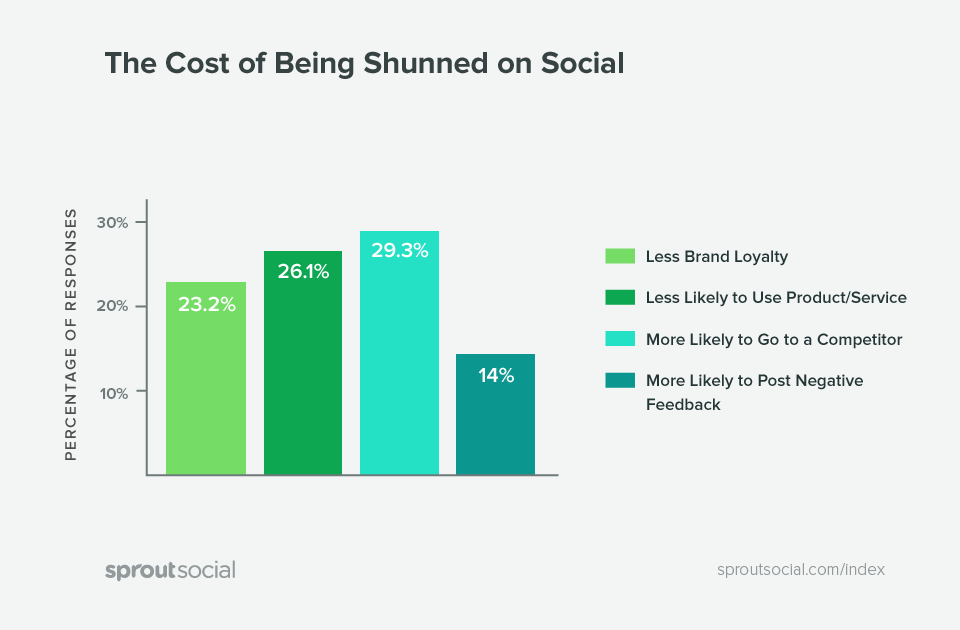
#5: Build connections with social media/online influencers
When people say “Social media does nothing for my brand,” most SEOs must think, “Oh, but how wrong you are.”
Whether it’s the largely unmeasurable dark traffic social sends to your site or the connections with a base of people who could be customers or supporters at some point, social media can be an asset for any brand, if used wisely.
For off-page SEO, one of the biggest benefits of social is the ability to create and nurture lasting relationships with influencers, those people with huge reach in the way of name recognition, myriad followers and fans, and connections with numerous high-ranking websites.
They’re also typically very much connected with other influencers.
As we see in the image below, even if Google isn’t using social signals to help determine rankings, the interplay of influencers and the sites they represent, like, and visit makes being on their radar a positive.

Image source
An effective strategy for enlisting the help of influencers to boost your off-page SEO is to get to know them in person, at events, and online via group chats/tweets and such, which puts you on their radar without much heavy lifting on your part.
Then, in the future, when you do create and share content, they’re more likely to recognize you and your brand and might share the content themselves.
Even better, later on, after you’ve developed a stronger relationship, you might even collaborate on a piece of content — for their site, your site, or a publisher such as an online magazine.
#6: Recommit to frequenting forums and discussion boards, and comment blogging
Want to get noticed by your desired audience and the influencers they follow?
Visit the most popular blogs in your vertical, and leave comments. In recent years, comment blogging has fallen off in popularity, in large part because comment spam led to most blogs no-following their links.
For the purpose of off-page SEO, links are less of a priority.
Your goal is simply to be where the action is and to leave a thoughtful comment that might catch the eye of the blogger, the platform’s editor, and any influencers who might be reading the content.
The same applies for sites like Reddit and Quora, where you can follow topics specifics to your brand or vertical and quickly get noticed for being knowledgeable, thoughtful, and empathetic in answering others’ questions or helping to drive discussion.

The SEO subreddit is very popular, frequented by many of the big names in SEO.
The relationships formed on these platforms have a way of paying huge dividends and can be invaluable for off-page SEO and reputation management.
Often someone notices your comments on one of these platforms, starts following you there, and then later does a Google or LinkedIn search to learn about you or your brand, which ultimately leads them to your website, where they might sign up for your newsletter or subscribe to your blog.
#7: Quit guest blogging for links
You read that right.
Instead of guest blogging solely for links, use this tactic to help you build a rapport with some of the top publishers, editors, influencers, and brands online.
If done correctly, the links do come. But as long as you make links the priority, whereby it’s obvious that you’re looking for a transactional relationship as opposed to one that is mutually beneficial, the tougher it’ll be for you to use guest blogging effectively for off-page SEO.
Read, leave comments on their blogs, and connect with the top publishers in your vertical — or publishers that cover your vertical. Once you have developed a rapport and, hopefully, have a reputation for creating quality content, inquire about creating a guest post for the platform, assuming that option is available.
Even if that door doesn’t open, you’ll be able to hone your pitch and eventually get a foot in the door with other publishers.
Remember, too, that your website is but one tiny fish in a vast ocean of options. You need to connect with others in many places off-site to build the reach and influence that’ll drive attention and visits to your site, which is where guest blogging can big a huge asset.

Your brand’s success depends upon a lot of factors outside your website. Image source
“Should you do guest posting for SEO? As a primary objective, I’d say no. But… reality is that the indirect impact remains very powerful,” wrote Stone Temple Consulting’s Eric Enge. “There is nothing like building your reputation and visibility to cause people to want more of your content. You get to build up your own audience, and ultimately some of these people will find their way to your site, find great content there, and link to it.”
Content
When most people say, think, or write “content,” they most often think of text, images, videos, and information shared via social media.
In reality, content represents the entirety of the experience your brand designs, creates, and shares online and offline, from logos and tag lines to personnel, phone calls, signage, blog text, images, videos, etc.
If a prospect or customer can interacts with it, you’d better believe it’s content.
And before you offer up, “Well, Ronell, what if one of my staffers has mustard on her shirt in a video we post online?” (Trust me, someone would ask that.) “Is that content, too?” Yes, that faux pas is part of the content experience a prospect or customer could have with your brand.
In fact, it’s the sort of thing that can lead to someone seeing your company as not having all of its ducks in a row, injuring your reputation in the process.
#8: Experiment with content types
But don’t fret. When it comes to off-site SEO, the main thing I want you to focus on with regard to content is to see beyond text.
I’m a writer. I love words.
As a newspaper reporter, I always argued with my editor when he said “Words without images lead to words getting ignored. Images sell.”
The same for video. People eat it up.
You’ve no doubt heard that mobile is gobbling up the world as I write this. Well, guess what those untold millions are doing on their mobile devices?
Largely consuming videos, which are expected to account for 85% of the content being shared online by 2019. Snapchat, Instagram, or Facebook Live, anyone?
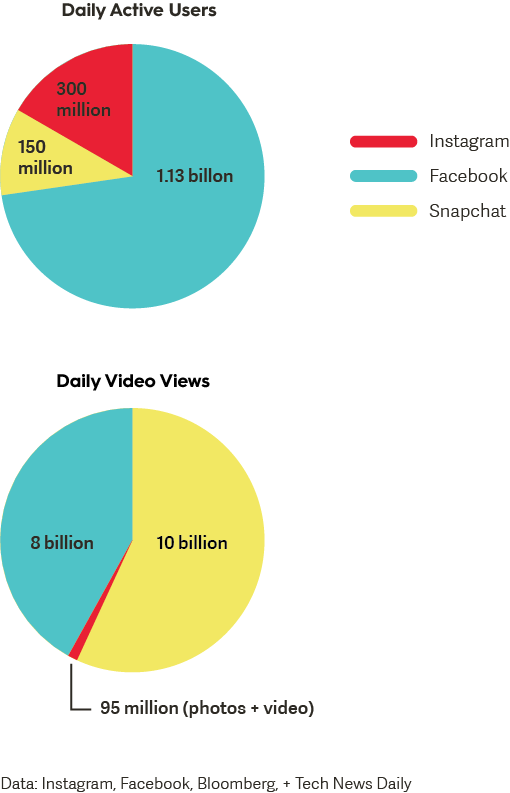
Image source
Videos and images can be a huge boon to your brand’s off-page SEO, largely because they can both be a low-investment/high potential vehicle used to drive awareness and traffic back to your site, enhancing your off-page reputation in the process.
A few low-cost, low-effort ways to use video and images include:
- Post how-to videos on YouTube, which is the second-most visited website in the world and the #2 search engine behind parent company Google. What’s more, popular videos can and do rank in the SERPs.
- Share daily musings or recaps of distillations of recent events via Facebook Live
- Snap meeting or office funnies via Snapchat
- Compose image albums on Imgur, Flickr, and other popular photo-sharing sites
- Tweet videos of interesting things you notice throughout the day
Video and images are great way to show some personality and make your brand feel human, real, and alive to people who might not have heard of your company, or who’ve only recently discovered it.
They can also work wonders for your off-site SEO.
For example, say your brand has found that customers who visit your white papers have an increased likelihood of becoming customers. You might shoot video interviews of the subjects or clients featured in the most popular websites, then post the videos to YouTube, in addition to sharing them with the clients to post on their site and disseminate via social media.
This increases the likelihood of even more people seeing the videos and wanting to learn more about your brand.
It’s time to think holistically
The complete list of off-site SEO tactics that can bring your brand success contains far more than eight elements.
Our goal with this post is to spur you to think beyond what’s comfortable or convenient, and instead consider what’s (a) doable in a reasonable amount of time and a reasonable degree of effort, and that (b) has the potential to yield a significant amount of success.
We’re convinced that a brand who works diligently to deploy the tactics listed above will be better able to thrive.
About Ronell Smith — Ronell Smith is a Moz Associate and business strategist who enjoys helping businesses create a user experience their customers will recognize, appreciate and reward them for with their business.
Beginner’s Guide to Influencer Marketing (& How it Boosts SEO Ranking)

It seems everyone you meet these days is a self-proclaimed influencer. Whether that’s over a multi-million plus following or their local book club, the significance of influencers has entered our daily lexicon and lives, and guess what, it’s here to stay.
As a business in 2017 it’s a marketing resource you can no longer neglect. In fact, a recent emarketer survey found that 84% of marketers intend on launching at least one influencer campaign in the next 12 months. Even more staggeringly, 94% of marketers from a variety of industries said influencer marketing was an effective strategy.
Finding key target influencers to develop strategic partnerships with will only take your brand and business to the next level.
Before diving into the complexities of a full frontal influencer campaign let’s go over the basics with this Beginner’s Guide to Influencer Marketing:
What in the World is an Influencer?
First, let’s take a step back and define influence.
In·flu·ence
Noun
- the capacity to have an effect on the character, development, or behavior of someone or something, or the effect itself.
With this in mind, an influencer is a person, or even in some cases a furry friend, that has established a level of authority and trust amongst their niche audience.
Unlike celebrity endorsements, influencers carefully select their affiliations, opting to partner with brands that reflect their personal branding and don’t alienate their followership. This close connection to their audience has fostered an environment where fans follow their every move, trusting their word sometimes above their very own friends and family.
Essentially they’ve curated the ability to affect and control customer purchasing decisions, and drive consumers to brands over others. Making them the ultimate potential trendsetter for your brand.
What’s amazing about an influencer is they can take many shapes and forms, and the term does not only apply to fashion and beauty bloggers. An influencer can be a journalist, author, commentator, industry insider, blogger, celebrity, happy customer, and the list goes on.
The ultimate goal with influence is to generate positive brand perception and awareness in a truly authentic and unique way. You’ll be in wonder of what some influencers can create with your brand!
Why Influencer Marketing Matters
Nearly 40% of Twitter users say they’ve made a purchase as a direct result of a Tweet from an influencer, according to Twitter.
With numbers like that, influencer affected purchases clearly aren’t are a one-off.
So let’s take a peek at a few successful influencer marketing campaigns that clearly illustrate Tomoson’s findings that “Influencer marketing was rated the fastest-growing online customer acquisition channel, beating organic search, paid search, and email marketing.”
Ok numbers, do the talking:
1. Lulus
We’ll start with coveted and viral fashion online store, Lulus. Started a number years ago as a fast-fashion ecommerce brand, now has transformed itself into every it girl’s go-to for chic and affordable looks.
What led to Lulus explosive growth and cult status? Influencer marketing. How did they do it?
Lulu’s partnered with fashion bloggers that fit their branding. By reaching out to bloggers of varying and diverse followers they were able to tap into a wide, yet targeted audience.
They then provided these bloggers with the ability to select clothing, shoes, and/or accessories that fit their own personal brand. Then encouraged them to share how they styled their Lulus look with their followers on social media and their blog, and of course, without forgetting to include the #lovelulus hashtag.
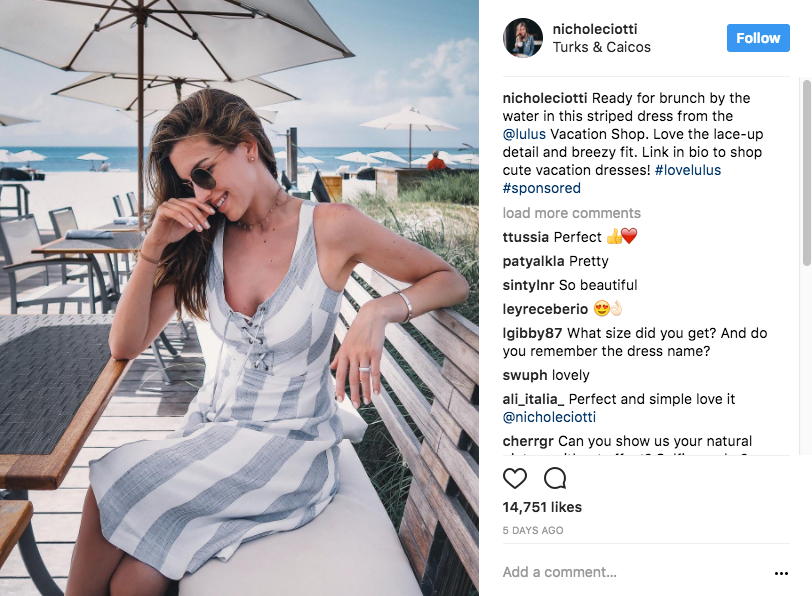
As you can see in the example above, by supplying @nicholeciotti with a dress (and possibly some payment) they put themselves in front of her 450K+ audience that attracted 14K+ likes. All while advertising in a way that’s natural and ultimately led to purchase conversions through her delicate call-to-action.
Lulus has built a business on this type of seemingly easy breezy influencer marketing. Imagine what you can do with your business!
2. Suja Juice
We couldn’t speak about influencer marketing without mentioning local San Diego company, Suja Juice! To say their Midnight Tonic campaign went viral, would be a major understatement.
And if you can believe it… they were able to get their products in the hands and in the feeds of major celebrities, influencers, and raving fans alike at no paid promotional cost.
Let’s dive in and learn how they pulled it off!
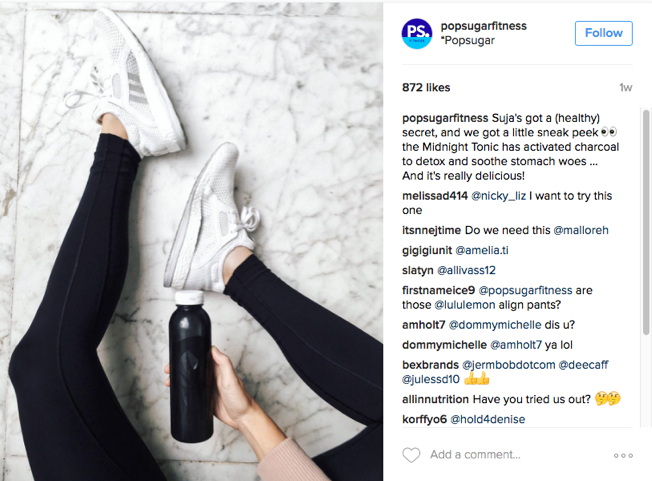
In September 2016, Suja Juice released Midnight Tonic, an all black, limited edition charcoal based beverage to health conscious celebrities with an active social media presence.
A fever pitch ensued, with fans clamoring to get their hands on one of the 1,000 bottles available they witnessed their favorite celeb devouring with enjoyment. The madness caused the site to crash and the product to sell out in three days.
A few of the celebs and outlets that organically posted on a variety of platforms about their experience were Eva Longoria, Jesse McCartney, Kristin Cavallari, and PopSugar.
The campaign generated an awe-inducing 16 million social impressions. Not to mention, countless new customers along the way. All achieved without paying anyone for the endorsement.
What gives this campaign more heart, and meaning beyond tallying up the numbers is how CMO Heather MacNeil Cox described their thought process.
“We chose influencers that have been organic fans of the brand since the beginning, people that love and drink Suja on their own. The Midnight Tonic surprise shipment was a way to thank them for their support, and also re-engage in a conversation about something new and cool.”
Ultimately, the immense success of this campaign stemmed more from the thought process of showing gratitude, rather than focusing solely on how many celebrities they could get to show off their product.
The organic nature of the celebrities’ show and tell of the limited edition Midnight Tonic and their need to be early adopters is what drove the tonic’s virality; the authentic display of a health beverage so tangibly intangible that everyone had to have just a taste.
Suja Juice, we salute you.
Perks of Successful Influencer Marketing & How it Impacts SEO
On a simplistic level the goal of SEO is to achieve links directed to your site from high ranking and authoritative sites in order to drive your rankings for specified keywords to Google’s lauded first page.
You may be thinking if you just get a few solid links from influencers then you’re golden, right? Not so fast turbo.
Link building is much more complex, and so let’s break it down in regards to how partnering with influencers in a strategic way is indeed a boon for your overall SEO goals.
Campaigns need three types of links to grow overall domain authority, as we’re assuming you’re striving to rank specific keywords and phrases on your site.
- Broad, High Domain Authority: This link will point to any section of your website, whether that’s the home page, an internal page, blog, etc. An example, would be Huffington Post, a highly authoritative web news source with a wide reach.
- Specific High-Value Keyword Targeted Pages (with specific anchor text): By doing this individual URLs’ rankings will receive a needed boost. The easiest way is to provide a keyword and associated link for the influencer to place into the copy of their blog post about your product or service. Thus making its inclusion seamless and natural.
- Topical Influence: In other words, links to your domain from other sites within the same niche that give your site more authority and influence in your sector. This linking strategy is particularly pertinent to influencer marketing partnerships. If you’re a technology startup with a revolutionary product, you want to get into the hands of bloggers and journalists who write about the latest and greatest in tech.
While the above may feel a tad overwhelming, if you get it right, you’re ensuring yourself a goldmine of opportunities to drive web traffic and revenue. Not only that, you’re giving your business the opportunity to build relationships with influencers who will become forever fans whether paid or not.
The time really is now to get in on the influencer marketing game. To learn more about how influencer marketing can support the growth of your business, check us out at https://abovethefoldagency.com.